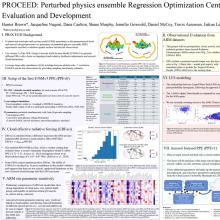PROCEEDing from the surface to climate sensitivity: a model constraint and understanding framework
Daniel
McCoy
University of Wyoming
Poster
Parameterized processes continue to be the largest source of uncertainty in the climate forcing and feedback predicted by Earth System Models (ESMs). One way to confront parametric uncertainty in ESMs is through a perturbed parameter ensemble (PPE). Here, we present preliminary work implementing a PPE hosted in E3SMv3 focusing on constraining aerosol-cloud-precipitation interactions (ACPIs). In situ and surface observations are a natural choice to confront and constrain the microphysical processes driving ACPIs, but the way to do that is somewhat ambiguous. Because of the scale mismatch between observation in situ and remotely from the surface we leverage Large Eddy Simulations (LES) to provide a robust sampling uncertainty. We present a path towards systematically leveraging observations to both constrain global quantities such as forcing, but also to provide understanding of how microscale processes imprint onto global scale phenomena. Our goal is provide a set of community tools that will allow others to readily leverage high-quality in-situ and surface observations to constrain global models. For details on the PPE Regression Optimization Center for ESM Evaluation and Development (PROCEED) project see https://github.com/PROCEED-ESM.

mccoy-brown-nugent-poster.pdf
(1.65 MB)
Meeting homepage
